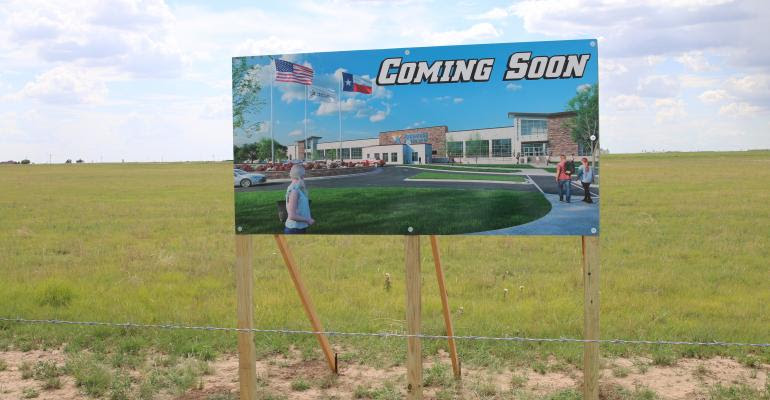|
News Bits
The USDA's good to excellent ratings on corn and soybeans sank slightly again last week. The crops are showing the impact of hot, dry weather in some key U.S. growing areas. That will get alleviated at least somewhat this week in parts of the region, but the USDA could trim yield estimates in the next crop production report.
As of Sunday, 57% of U.S. corn is in good to excellent condition, 1% less than last week, with 94% of the crop silking, compared to the five-year average of 97%, 62% at the dough making stage, compared to 65% on average, and 16% dented, compared to the normal rate of 20%.
58% of soybeans are called good to excellent, down 1%, with 93% of the crop blooming, matching the five-year average, and 74% at the pod setting stage, compared to 77% most of the time in mid-August.
90% of winter wheat is harvested, compared to 94% on average.
64% of spring wheat is in good to excellent shape, unchanged on the week, with 16% harvested, compared to the usual pace of 35%.
34% of the cotton crop is rated good to excellent, up 3%, with 80% setting bolls, compared to 78% on average, and 15% of those bolls opening, compared to 14% on average.
75% of U.S. rice is reported as good to excellent, 1% higher, and 84% has headed, compared to 86% typically this time of year, and 11% harvested, in-line with the normal pace.
21% of U.S. pastures and rangelands are in good to excellent condition, a week-to-week decline of 3%.
A Tax on Meat? by Cameron Hepburn, Professor of Environmental Economics, University of Oxford and Franziska Funke, Associate Doctoral Researcher in Environmental Economics, Potsdam Institute for Climate Impact Research
Rearing livestock and growing crops to feed them has destroyed more tropical forest and killed more wildlife than any other industry. Animal agriculture also produces vast quantities of greenhouse gas emissions and pollution.
The environmental consequences are so profound that the world cannot meet climate goals and keep ecosystems intact without rich countries reducing their consumption of beef, pork and chicken.
To slash emissions, slow the loss of biodiversity and secure food for a growing world population, there must be a change in the way meat and dairy is made and consumed.
A rapidly evolving market for novel alternatives, such as plant-based burgers, has made the switch from meat easier. Yet in countries such as Britain, meat consumption has not fallen fast enough in recent years to sufficiently rein in agricultural emissions.
Instead, prices on meat and other animal products will eventually need to reflect all this damage. There are several ways to do this, but each intervention poses its own difficulties.
In our view, the most likely result will be simple, direct taxes on meat and animal products. Our latest research, published in the Review of Environmental Economics and Policy, considered how an environmental tax on meat could work.
To read entire article, click here
Source: House Agriculture Republicans news release
WASHINGTON, DC -House Democrats passed H.R. 5376, a disingenuous and partisan exercise that lacked robust debate and hearings and does nothing to provide relief to rural America. Following the vote, Rep. Glenn "GT" Thompson (PA-15), Republican Leader of the House Agriculture Committee, issued the statement below:
"America's farm families and consumers are continuing to grapple with an economic recession, yet today Speaker Pelosi and House Democrats jammed through another reckless tax-and-spend package.
"My Democrat colleagues are either politically deaf or blinded by ideology as they ignore 40-year high inflation, exorbitant food and fertilizer prices, severe labor shortages, and relentless overregulation from the Biden Administration, and instead voted to advance another fiscally irresponsible, partisan bill.
"As I've said, this bill only complicates the pathway to a Farm Bill and creates even greater uncertainty for farmers, ranchers, and rural communities."
Editor's Note: Space does not permit listing all the national agricultural groups and affiliates heaping praise on the Biden administration for the portions of pork made available for their constituents within the "Inflation Reduction Act." Many are the same organizations that have previously both blessed, and cursed, the Biden administration for foregone mercies or offenses. We're having fun counting the individual praises versus condemnations. There is, to many, much in the bill for agriculture. We worry about attitudes based on "free money" as there is scarcely such a thing, especially coming from an administration keen on reinstating, and introducing additional, regulation.
In previous Weekly Updates we have reported on the extreme drought conditions in France. As hard as it may be to believe they are dryer than we are - the worst drought in French recorded history - which goes back a bit further than recorded history in Texas. Apparently the sorghum crops, there aren't that many in France, are doing stunningly well as corn and wheat crops have faded into distant memories. Could be an opportunity for more hybrid grain sorghum seed sales in France next year.
|
 CATTLE PRODUCERS TO BUILD NEW BEEF PROCESSING PLANT IN AMARILLO, TX
CATTLE PRODUCERS TO BUILD NEW BEEF PROCESSING PLANT IN AMARILLO, TX CATTLE PRODUCERS TO BUILD NEW BEEF PROCESSING PLANT IN AMARILLO, TX
CATTLE PRODUCERS TO BUILD NEW BEEF PROCESSING PLANT IN AMARILLO, TX